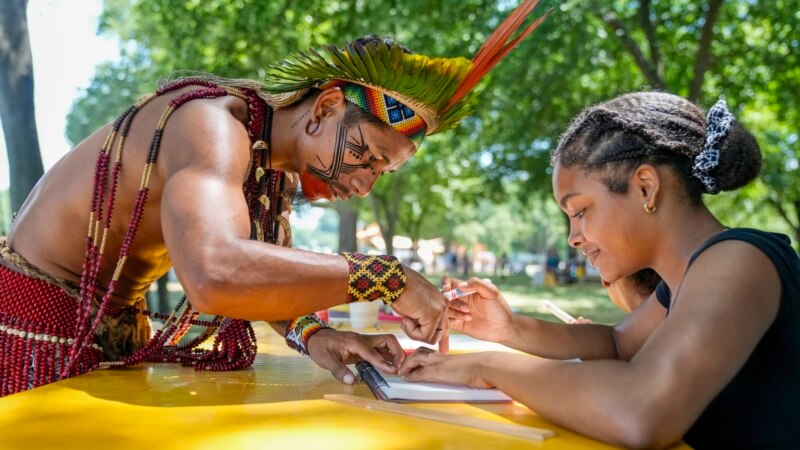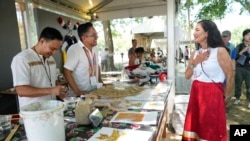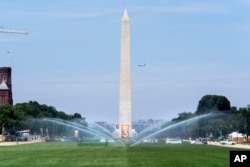This website uses cookies so that we can provide you with the best user experience possible. Cookie information is stored in your browser and performs functions such as recognising you when you return to our website and helping our team to understand which sections of the website you find most interesting and useful.

Washington's National Mall was buzzing with activity Wednesday, despite temperatures surpassing 36 degrees Celsius (96.8 Fahrenheit). Groups of children played lacrosse while the dynamic notes of music and the savory aromas of food wafted along the grassy blocks.
Visitors found themselves immersed in the first day of the Smithsonian Folklife Festival, running through July 1. This year, the festival celebrates Indigenous communities.
The festival, which calls itself "an exercise in cultural democracy," began in 1967. Its programming generally focuses on a nation, region, state, or theme, seeing hundreds of thousands of visitors per year. Since its founding, the festival has hosted more than 25,000 guest performers, cooks, artists, and speakers.
The 2024 festival has pivoted its focus, honoring Indigenous communities in alignment with the 20th anniversary of the National Museum of the American Indian, which is adjacent to the Mall. Around 60 countries are being represented throughout the festival.
"Change is very much part of the festival … It's not cookie-cutter. It allows us to be flexible and to lean into moments that really are important," Sabrina Motley, director of the Smithsonian Folklife Festival, told VOA.
This year's festival is also on the shorter side, spanning just six days instead of the typical 10.
"We wanted to use the time before the 4th of July. The building itself, the thing we're celebrating, has a different life on the 4th of July," said Motley.
"It is becoming increasingly more difficult to ask people to come to Washington for two weeks … I'd rather have the most wonderful artists and cooks and dancers and musicians that we can find here for six days than to try to squeeze the festival into a longer period, which would be harder on the people that we're really meant to honor," she added.
Celebration strengthens bonds, says official
The 2024 festival began with a welcome ceremony in the museum's Rasmuson Theater, followed by an outdoor presentation of colors with Native American Women Warriors. Simultaneously, events were already happening on the National Mall.
"Every day that we celebrate, every day that we dance and sing and pray, we strengthen the bonds that assimilation policies sought to break among Native people. Thank you for telling our stories and keeping them alive," said U.S. Secretary of the Interior Deb Haaland at the welcome ceremony. Haaland is the first Native American to serve as a Cabinet secretary.
Crowds attending the opening ceremonies spilled into the rest of the museum and the National Mall, where tents with music, food, and activities were scattered across the grass.
Each day of the festival has dozens of indoor and outdoor events from late morning to early evening. There are musical performances, cooking demonstrations, and speaker discussions. Several events occur at the same time, and most span less than an hour, allowing visitors to pop between tents and performances.
While scheduled events are occurring, the "Festival Kitchen," a tent pitched outside the museum, sells a variety of food, such as Peruvian chicken, chicken empanadas, and Mexican chocolate gelato.
Music, fritters, lacrosse lessons
Despite the ongoing heat, the first day had a range of events.
In the late morning, the Gaudry Boys, a group specializing in folk music, played upbeat tunes on an outdoor stage as audiences tapped their toes against the lawn and bobbed their heads to the music.
Later in the day, Bradley Dry, a Cherokee chef, prepared corn fritters at the Foodways tent, an enclosure designed for cooking demonstrations. As he mixed a batter fragrant and orangey from smoked paprika and dropped the fitters into crackling oil, he spoke about his history with cooking, family, and culture.
"This [recipe] was something that was brought over with my family during the Trail of Tears. We don't have anything written down, but it's all just passed down through stories," he said. The Trail of Tears was a path taken by the Cherokee people when they were forcefully relocated from their homelands and moved to Oklahoma.
Other events from the first day included lacrosse lessons taught by Haudenosaunee tribal grouping athletes, a skateboarding workshop with Imilla Skate, a women's Indigenous skateboarding group, and evening blues piano.
Artistry, such as Tsimshian woodcarving and adornment and body art from Indigenous Brazil, was showcased throughout the day, while a temporary garden for the festival housed native plants.
The remaining days have a similar lineup, with events happening across the National Mall and museum.



 Africana55 Radio
Africana55 Radio 



